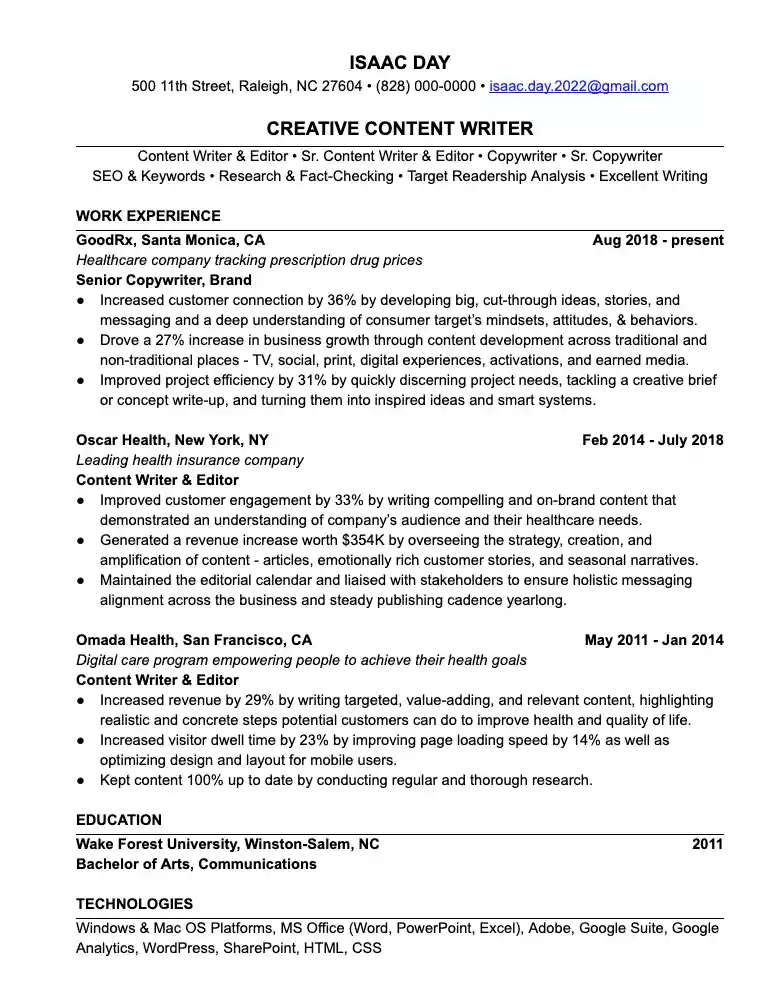Risk Analyst Resume Example
Learn how to write a Risk Analyst resume that gets you more interviews and job offers…or have Leet Resumes do the writing for you.


The Risk Analyst Resume that Gets Interviews
Risk analysis is more about opportunity than anything else. Sure, you tell companies where to steer to navigate around risky projects, investments and strategies, but it’s all about getting them to open waters of opportunity.
That’s kind of where you are now: searching for a Risk Analyst position that utilizes your skills and knowledge in a way that’s rewarding. The only problem…that pesky resume.
Whether through fortune, assessment or a little of both, you’ve landed in the perfect place. In this article, you’ll find:
- A step-by-step guide for writing a Risk Analyst resume
- A resume template, specifically for Risk Analysts
- A Risk Analyst resume example for reference
- Expert resume tips along the way to help you stand out and land more interviews
Prefer to have someone else write your resume?
Great news! Leet Resumes will write your Risk Analyst resume for you. Better yet, they’ll do it for free (though tips are appreciated). Now that’s a real no-risk situation!
What to Include in a Risk Analyst Resume
There are five essential components to this resume template:
- Professional Headline
- Professional Summary
- Work Experience
- Education
- Keywords
As you go through this guide, keep these two tips in mind: Simple is best.
Don’t be strayed by fancy columns, colors, or fonts. Your resume serves one purpose: landing an interview.
For the person who reads resumes all day, they’re not looking for your design skills, they just want to see your qualifications and how your risk analysis brings success. Make it easy for them by sticking to the single-column, black and white template you see in the resume example.
Don’t use paragraphs.
Let’s say you complete an independent risk assessment with a twenty page report and correlating graphs and data visualizations. Where does your audience turn first? For the brief time a recruiter spends scanning your resume, you need to hit them with the hard facts fast. That means quantitative data, lists, bullet points and short phrases.
Now, let’s get started on creating opportunities with one stellar resume.
Name + Contact
First and foremost, add your full name to the top of the page. Choose a professional and legible font that’s slightly larger than the rest of the text.
Underneath, add your contact information:
- Phone Number (one number where you can actually be reached)
- Email Address (something professional that you check regularly)
- Location (city and state is all you need)
Professional Headline
Your headline is the brief summary of your career in three to five words – the elevator pitch that will capture the interest of your reader and make them want to read more of your resume.
Start with a flattering adjective that highlights the quality of your analysis work. This might be: results-oriented, economical, strategic or proactive.
Then add a word to describe your level of experience, like: executive, senior, junior, assistant, etc.
Finally, complete your professional attention-getting headline with your official job title.
The final product should read something like this: Results-Oriented Executive Risk Analyst.
Professional Summary
Now that they’ve identified who you are and shown some interest, you’ll help them evaluate the risks of hiring you. To make it exceptionally clear that you’re a low-risk hire, your professional summary will outline the different ways your risk analysis mitigates their risk of hiring you. Here’s how:
In the first line, list the job titles you’d accept for your next position (Risk Management Analyst, Quantitative Risk Analyst, Risk Assessment Consultant, etc.).
Most importantly, include the exact job title for the position you’re applying for to position yourself as the most compatible candidate.
In the second line, add the professional skills you’d use in this specific role.
To find inspiration, visit the original job posting and review the qualifications they’ve listed to understand their HVRAs. List the specific skills and technologies within your arsenal. This might include data analysis, SQL, Python, risk management, process standards or risk auditing.
You won’t be able to fit every skill here, so choose the most relevant to the targeted position and you can add the rest to the keywords section later.
The third and fourth lines are optional. If nothing comes to mind to fill them, don’t worry about it. Lines one and two are enough to land you an interview.
In line three, list your career achievements in risk analysis and in line four, add any awards or promotions you’ve received for your work.
Need a break?
We get it. Analyzing the data is more your style than creating the data yourself. If you’d like to hand off your Risk Analyst resume to the experts, Leet Resumes will write it for you, for free. (Tips are always appreciated.)
Work Experience
When an organization is looking to hire a Risk Analyst, the likelihood of a pre-existing vulnerability is pretty high. The best way to show them that you’re fit to steer their ship is through your work experience.
Historically, many analysts might share how they were “responsible for financial and market analysis, monitoring data points, reporting to executives and conducting risk assessments for internal controls.”
Wow, snooze alert.
Sorry to break the news, but no one wants to read an instruction manual about how you actually do your job, they just want to know the results your work brings. Specifically, numbers.
Here’s how to create fans of your analysis and get more interviews:
Start by listing your previous work history in reverse chronological order. Take a look at the resume example to see how your job title, dates of employment and previous employer information should be formatted. (Be 100% accurate on these details – no need to cause doubt in your precision here.)
Under each position, make a bulleted list of your accomplishments and achievements in each role. This isn’t a list of your duties and responsibilities. These are mini case studies of your analyses, beneficial findings and positive contributions for previous employers filled with these three items:
Strong Success Verbs
Instead of sharing what you were responsible for, use success verbs that imply the positive outcome of your work before you even mention the details. These are verbs like resolved, secured, accelerated, advanced, optimized or capitalized. Highlighting the results of your work rather than the work itself shows your value to anyone, even the hiring HR rep who has no idea what KRIs are. So start every bullet point with a strong success verb.
Numbers
Measurable data is the key to a great resume because it’s specific. For this reason, use as many numbers as possible in your Risk Analyst resume. Outline the opportunities you’ve created through your analyses by way of successful investments (dollar amounts), market pivots (market share/user growth) and optimization (increased efficiencies in controls and processes, reduced expenses, etc.).
There is no such thing as too many numbers in your work experience. Once you think you’ve added enough, double the amount again. You can refer to the resume example for more inspiration on Risk Analyst stats to include.
Promotions
For the most risk-averse of potential employers, promotions are a quality qualifier. With a third-party’s word for it, you have a history of creating work that’s rewarded.
Promotions add another dimension to your success, and one that further positions you as the ideal Risk Analyst for their team.
Education
Simply and concisely, you’ll outline your educational background here.
Refer to the resume example for formatting to include where you attended school, your dates of attendance, the degree(s) obtained and any honors or awards.
There’s no need for any extracurriculars or incomplete degrees here. Just the basic educational facts.
Keywords and Skills for a Risk Analyst Resume
In the final section of your resume template, you’ll list the skills and qualities you have that make you the best Risk Analyst for the open position.
In addition to using the posted job listing to share skills that target their needs, include a combination of the following to highlight your diverse skill set and unique expertise:
Soft skills that share your contributions to the team and work environment.
- Project Management
- Portfolio Management
- Excellent Verbal and Written Communication Skills
- Growth Mindset
Hard skills that are intrinsic to risk analysis, and/or industry-specific to the position you’re applying for.
- Risk Auditing
- Regulatory Risk
- Risk Education
- Risk Mitigation
- RCSAs
- Key Controls Testing
- Control Documentation
- Statistics
- Data Structures
Technologies you employ to implement these skills.
- SQL
- Python
- Microsoft Office 365
- ETL Tools (IBM DataStage, Oracle Data Integrator, SAS Data Management)
- Fusion Framework System
These are just a few suggestions to use as inspiration for your own resume template. Choose the keywords and skills that are most relevant to your field of expertise and the position you’re applying for, and your recruiter will have even more reason to request an interview.
Can someone write my resume for me?
Absolutely. The experts behind this guide and Risk Analyst resume template will write yours for you. Also, it’s completely free. (Tips for a job well done are always appreciated.)










